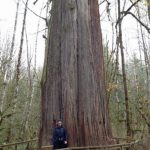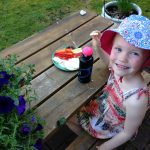It rained for the first time in months. A small group of people gathered in a special place on the traditional territory of the Squamish Nation, to witness an event. The event was the raising of a reconciliation pole and a witnessing ceremony to give the artist, who carved the piece, his spirit back. It is known that when an artist carves a pole, he gives his spirit to the pole. When he finishes the piece and it is ready to be raised, a ceremony must take place to take back his soul from the tree so he can move on and live his life. Four people were called to witness the event. They were given a token at the beginning of the ceremony and they gave it back when they came up to speak. They each shared what they had learned. Four women, representing different families, brushed the pole with cedar branches after dipping them in fresh water, to cleanse the piece from any bad spirits or negative energy. They also needed to clear the spirit from the pole and pass it back to the artist. We were all witnesses to this event and therefore all have a responsibility to share our experience and learning with others.
“Today we open up the eyes of the pole as the pole was coming up. The pole is alive we woke it up through the ceremony. Our ancestors tell us that we are in a constant state of reconciliation with all of creation as Indigenous people, especially the Skohomish, we reconcile ourselves with the natural world, with all of creation, every day. We pray that we can live in harmony with all of creation, including everybody in all walks of life.”
“It’s not an easy process, but if we work together, something beautiful will come out if it, like this pole. It will be something that will last for the next generations.” (Words spoken by Chris Lewis, Squamish Nation councillor)
During the ceremony, after the pole was raised for all to see, the artist, Xwalacktun, explained the meaning of the Cheakamus Centre House Post to the witnesses. “To symbolize the change between what took place, what happened and where we are going now, there is a butterfly on top. The butterfly symbolizes that change because the butterfly has four stages of change in its life cycle. The eagle is there to remind us that we’re being watched and it is connected to something greater than us. That is why the eagle’s eyes are in the spiritual form, looking further than its normal vision. The eagle also symbolizes enlightenment and strength. The person in between the eagle ties this pole in with reconciliation because you can see the hands are up. This is showing the gesture of thank you for finally recognizing what took place and where we are going now. In between the eagle and the salmon is the Coast Salish eye that shows connection to something greater than us. To have that reconciliation we need to find balance again. The two salmon symbolize that balance, the male and female. With that balance we become a whole family again and the wolf represents family. The wolf is on the bottom feeling happy and well fed in many different ways; through education and food and nurturing.”
I first met Xwalacktun at the Cheakamus Centre, where I teach, while he was carving the Reconciliation pole for several months on the property. While carving this pole he mentored and included others in its journey. He carved this pole beside the traditional Coast Salish Big House, a place where cultural programs are shared with students about Squamish Nation culture and stories. Xwalacktun has a longstanding relationship with this Big House, having designed it in 1983 when he was 25. The Reconciliation pole will remain at the Cheakamus Centre in the Paradise Valley on the traditional territory of the Squamish Nation people, in Cheekeye Village. It is clear to see and understand that the Cheakamus Centre House Post is connected to the land because the symbolism is represented by animals, both mythical and real. Xwalacktun explained to me that he believes the ancestors are always around. The ancestors guide him to do his artwork in the way that he does. Xwalacktun explains that he creates native art with a connection to the past, present and future like his ancestors did. Squamish Nation artwork shares important stories about connections to the land that can be used to inspire respect, protection and sustainability for future generations for all. By sharing stories with others that they can relate to, they too can connect with the land and connect with him and his culture.
In an interview with the Pique News Magazine, when asked what the project of a Reconciliation Pole meant to him, Xwalacktun said that he feels he has been working on it for a lot of years. He said that “I have always been focused on that truth and reconciliation idea, but I didn’t know the words. I just wanted people to understand who we were and where we come from.” He explained that he occasionally brings up the stories from the past, and hopes to plant the seed to be able to move on to where we are today. Xwalacktun believes that reconciliation will involve a long process for many people because there were several generations who went to residential schools. He explained that when people have been through trauma, it gets passed on through families. There is a lot of healing to be done. Xwalacktun believes the way to heal is to do it experientially by spending time in the mountains, on the land. Another way to heal is to educate others and share and learn stories from the land. Xwalacktun shared that it is so valuable for people to feel a connection to something greater than us. For example, he taught me that the Thunderbird is supernatural. It is so big and so small that we can’t see it. It is all around us. He grew up being taught to respect everything. Xwalacktun believes that if we look after the land, it will look after us.
I first met Xwalacktun at the Cheakamus Centre, where I teach, while he was carving the Reconciliation pole for several months on the property. While carving this pole he mentored and included others in its journey. He carved this pole beside the traditional Coast Salish Big House, a place where cultural programs are shared with students about Squamish Nation culture and stories. Xwalacktun has a longstanding relationship with this Big House, having designed it in 1983 when he was 25. The Reconciliation pole will remain at the Cheakamus Centre in the Paradise Valley on the traditional territory of the Squamish Nation people, in Cheekeye Village. It is clear to see and understand that the Cheakamus Centre House Post is connected to the land because the symbolism is represented by animals, both mythical and real. Xwalacktun explained to me that he believes the ancestors are always around. The ancestors guide him to do his artwork in the way that he does. Xwalacktun explains that he creates native art with a connection to the past, present and future like his ancestors did. Squamish Nation artwork shares important stories about connections to the land that can be used to inspire respect, protection and sustainability for future generations for all. By sharing stories with others that they can relate to, they too can connect with the land and connect with him and his culture.
In an interview with the Pique News Magazine, when asked what the project of a Reconciliation Pole meant to him, Xwalacktun said that he feels he has been working on it for a lot of years. He said that “I have always been focused on that truth and reconciliation idea, but I didn’t know the words. I just wanted people to understand who we were and where we come from.” He explained that he occasionally brings up the stories from the past, and hopes to plant the seed to be able to move on to where we are today. Xwalacktun believes that reconciliation will involve a long process for many people because there were several generations who went to residential schools. He explained that when people have been through trauma, it gets passed on through families. There is a lot of healing to be done. Xwalacktun believes the way to heal is to do it experientially by spending time in the mountains, on the land. Another way to heal is to educate others and share and learn stories from the land. Xwalacktun shared that it is so valuable for people to feel a connection to something greater than us. For example, he taught me that the Thunderbird is supernatural. It is so big and so small that we can’t see it. It is all around us. He grew up being taught to respect everything. Xwalacktun believes that if we look after the land, it will look after us.





